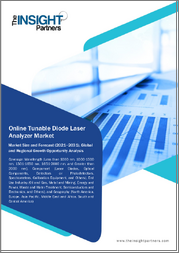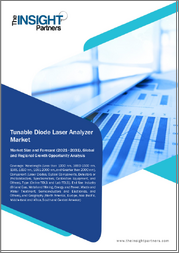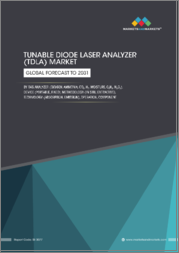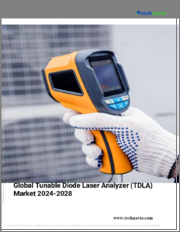
|
시장보고서
상품코드
1847865
파장 가변 다이오드 레이저 분석기 시장 : 디바이스 유형별, 기술 유형별, 측정 가스별, 광로장 범위별, 용도 유형별, 판매채널별 - 세계 예측(2025-2032년)Tunable Diode Laser Analyzer Market by Device Types, Technology Type, Gas Measured, Path Length Range, Application Type, Sales Channel - Global Forecast 2025-2032 |
||||||
파장 가변 다이오드 레이저 분석기 시장은 2032년까지 연평균 복합 성장률(CAGR) 6.94%로 9억 5,053만 달러에 이를 것으로 예측됩니다.
| 주요 시장 통계 | |
|---|---|
| 기준 연도 : 2024년 | 5억 5,552만 달러 |
| 추정 연도 : 2025년 | 5억 9,124만 달러 |
| 예측 연도 : 2032년 | 9억 5,053만 달러 |
| CAGR(%) | 6.94% |
튜너블 다이오드 레이저 분석기의 기술적 강점, 새로운 산업 응용 분야, 최신 공정 제어에서 운영상의 이점을 강조하는 간결한 기본 개요
튜너블 다이오드 레이저 분석기는 정밀한 실시간 가스 모니터링이 필요한 산업에서 중요한 계측기 등급으로 성장했습니다. 좁은 선폭의 반도체 레이저와 파장 선택적 흡수 분광법을 활용하는 이 시스템은 높은 시간 분해능, 장기 안정성, 최소한의 시료 준비로 화학종 특이적 검출을 실현합니다. 산업 운영 및 환경 규제 당국이 배출가스 투명성 향상, 안전 모니터링 및 공정 최적화를 요구함에 따라, 가변 파장 다이오드 레이저 기술은 틈새 실험실 설정에서 연속 모니터링, 휴대용 조사 및 통합 제어 루프에 대한 광범위한 배포로 이동하고 있습니다.
이 기술의 핵심 장점인 빠른 응답, 다양한 대상 가스에 대한 상호 간섭에 대한 내성, 비침습적 현장 측정 옵션은 광범위한 이용 사례를 지원합니다. 또한, 다이오드 제조, 포토닉스 통합 및 임베디드 분석의 발전으로 인해 작동의 복잡성이 감소하여 보다 엄격한 교정 및 원격 진단이 가능해졌습니다. 그 결과, 플랜트 엔지니어부터 컴플라이언스 담당자에 이르기까지 다양한 이해관계자들이 튜너블 다이오드 레이저 분석기를 배출량 보고의 불확실성을 줄이고, 고장 감지를 가속화하며, 공정 효율화 이니셔티브를 지원하는 전략적 자산으로 인식하고 있습니다. 이 소개에서는 시장 변화, 관세의 영향, 세분화의 역학, 지역적 뉘앙스, 그리고 변화하는 상황을 헤쳐나가는 리더를 위한 전술적 권장 사항 등을 자세히 살펴봅니다.
규제 압력, 포토닉스 혁신, 디지털 통합, 공급망 역학의 주요 변혁적 변화로 인해 각 산업 분야의 분석기 채택이 변화하고 있습니다.
가변파장 다이오드 레이저 분석기를 둘러싼 환경은 기술 제공업체와 최종 사용자에게 혁신적인 결과를 가져다주는 몇 가지 동시 다발적인 힘에 의해 재구성되고 있습니다. 메탄, NOx, 온실가스 보고에 대한 규제가 강화됨에 따라 산업체들은 지속적이고 감사 가능한 측정 솔루션을 도입해야 합니다. 동시에 디지털 전환에 대한 노력은 독립형 계측기에서 클라우드 분석에 공급하고, 예지보전을 가능하게 하며, 자동 제어 루프를 지원하는 네트워크화된 센싱 아키텍처로의 전환을 가속화하고 있습니다.
마찬가지로 중요한 것은 포토닉스와 소형화의 발전으로 인해 이용 사례의 대응 범위가 넓어지고 있다는 점입니다. 휴대용 및 핸드헬드 유닛의 성능이 향상되어 신속한 누수 감지 및 비상 대응을 지원하는 한편, 소형 고정형 구성은 좁은 공간이나 이동식 장비에 널리 수용되고 있습니다. 공급망의 변동은 공급업체의 전략적 다각화를 촉진하고, 조달 주기의 리스크를 줄이기 위해 모듈식 설계를 채택하도록 유도하고 있습니다. 이와 함께, 수소 경제, 메탄가스 감축 노력, 에너지 전환의 엄격한 기한에 따른 부문 간 수렴은 전통적인 스택 모니터링과 새로운 연료 유형의 미량 가스 감지를 통합하는 새로운 응용 분야를 창출하고 있습니다. 이러한 변화는 부품 수준뿐만 아니라 서비스, 소프트웨어 통합, 지역별 시장 모델의 혁신을 제조업체에 요구하고 있습니다.
2025년 미국의 새로운 무역 조치가 분석기기의 가치사슬에서 공급망 의사결정, 제품 현지화 전략, 구매자의 조달 행동에 미치는 영향에 대한 평가
2025년 미국에서 추가 무역 조치를 시행하기로 한 정책 결정은 파장 가변 다이오드 레이저 분석기 생태계에서 제조업체, 통합업체 및 구매자에게 명확한 제약과 적응 요구 사항을 가져옵니다. 관세 인상은 레이저 다이오드, 특수 광검출기, 정밀 광학 부품 등 수입 부품의 상륙 비용을 상승시킬 수 있으며, 이로 인해 공급업체는 가격 구조, 현지화 전략, 재고 정책을 재검토해야할 것입니다. 구매자의 경우, 총소유비용 계산에 더 높은 초기 자본 지출과 공급업체의 리드타임 변동 가능성이 포함되기 때문에 조달 주기가 길어질 수 있습니다.
이에 대응하여 몇 가지 전략적 행동이 나타나는 경향이 있습니다. 공급업체들은 관세의 영향을 줄이고 서비스 대응력을 향상시키기 위해 니어쇼어링을 가속화하거나 지역 조립 허브를 설립하는 경우가 많습니다. 제조 시 설계 능력이 높은 기업은 모듈식 아키텍처를 활용하여 관세의 영향을 받는 모듈을 국내 조달품으로 대체할 수 있습니다. 구매자와 시스템 통합사업자는 장기 서비스 계약, 연장 보증, 예비 부품 재고를 우선적으로 확보하여 혼란에 대비할 수 있습니다. 중요한 것은 규제 중심의 컴플라이언스 등급 분석에 대한 수요가 가격 민감도를 완화하고, 견고한 현지 서비스 네트워크와 교정 역량에 대한 투자를 촉진할 수 있다는 점입니다. 이러한 적응은 공급망 민첩성, 제품 모듈성, 강력한 지역 서비스 발자국을 결합할 수 있는 기업에게 보상을 제공함으로써 경쟁 역학을 변화시킵니다.
제품 유형, 광학 아키텍처, 가스 타겟, 광 경로 길이, 응용 분야, 판매 채널이 제품 및 서비스 전략을 결정하는 방법, 세분화 중심의 세부적인 관점 공개
세분화는 제품 설계, 배포 전략, 서비스 모델이 파장 가변 다이오드 레이저 분석기의 상황에 따라 어떻게 달라지는지 이해할 수 있는 구조화된 렌즈를 제공합니다. 장치 유형에 따라 시장은 고정형과 휴대용 구성으로 조사되었으며, 고정형 장치는 연속 공정 제어 및 배출 모니터링에 최적화되어 있으며, 휴대용 장치는 신속한 현장 조사 및 비상 대응에 우선순위를 두고 있습니다. 기술 유형별로는 교차 덕트형, 추출형, 현장형이 있으며, 교차 덕트형은 스택 및 덕트 정렬 및 접근이 가능한 경우에 적합하고, 추출형은 제어된 샘플링 및 실험실 수준의 조건에서 고감도 용도에 적합합니다.
자주 묻는 질문
목차
제1장 서문
제2장 조사 방법
제3장 주요 요약
제4장 시장 개요
제5장 시장 인사이트
제6장 미국 관세의 누적 영향 2025
제7장 AI의 누적 영향 2025
제8장 파장 가변 다이오드 레이저 분석기 시장 디바이스 유형별
- 고정
- 휴대용
제9장 파장 가변 다이오드 레이저 분석기 시장 : 기술 유형별
- 크로스 덕트
- 추출 분석 장비
- 인 사이 츄-애널라이저
제10장 파장 가변 다이오드 레이저 분석기 시장 가스 측정별
- 암모니아
- 이산화탄소
- 일산화탄소
- 기체 산소
- 염화수소
- 불화 수소
- 황화수소
- 메탄
- 수분/수증기
제11장 파장 가변 다이오드 레이저 분석기 시장 : Path Length Range별
- 100mm-400mm
- 400mm-800mm
- 100mm 미만
- 800mm 이상
제12장 파장 가변 다이오드 레이저 분석기 시장 : 용도 유형별
- 화학 및 제약 업계
- 식품 및 음료
- 생산 라인 감시
- 품질 관리
- 석유 및 가스
- Downstream
- Midstream
- Upstream
- 발전
- 원자력발전소
- 화력발전소
- 물 및 폐기수처리
- 산업 배수 처리
- 도시 수처리
제13장 파장 가변 다이오드 레이저 분석기 시장 : 판매채널별
- 오프라인
- 직접 판매
- 유통업체/딜러 네트워크
- 온라인 판매
제14장 파장 가변 다이오드 레이저 분석기 시장 : 지역별
- 아메리카
- 북미
- 라틴아메리카
- 유럽, 중동 및 아프리카
- 유럽
- 중동
- 아프리카
- 아시아태평양
제15장 파장 가변 다이오드 레이저 분석기 시장 : 그룹별
- ASEAN
- GCC
- EU
- BRICS
- G7
- NATO
제16장 파장 가변 다이오드 레이저 분석기 시장 : 국가별
- 미국
- 캐나다
- 멕시코
- 브라질
- 영국
- 독일
- 프랑스
- 러시아
- 이탈리아
- 스페인
- 중국
- 인도
- 일본
- 호주
- 한국
제17장 경쟁 구도
- 시장 점유율 분석, 2024
- FPNV 포지셔닝 매트릭스, 2024
- 경쟁 분석
- ABB Ltd.
- Airoptic Sp. z o.o.
- AMETEK Inc.
- Analytical Technology and Control Limited
- Axetris AG by Leister AG
- Baker Hughes Company
- Cemtek Instruments, Inc.
- Ektimo Pty Ltd.
- Emerson Electric Co.
- Endress+Hauser Group Services AG
- Envea Global
- Esegas
- Focal Point Technology Ltd.
- Focused Photonics Inc.
- Fuji Electric Co., Ltd.
- General Electric Company
- Gentec Electro-Optics, Inc.
- HORIBA, Ltd.
- Koshin Kogaku Co., Ltd.
- Metrohm AG
- Mettler-Toledo International Inc.
- Sacher Lasertechnik GmbH
- Servomex by Spectris PLC
- SICK AG
- Siemens AG
- Steam Equipments Pvt Ltd.
- Teledyne Instruments, Inc.
- TOPTICA Photonics AG
- Unisearch Associates Inc.
- Yokogawa Electric Corporation
The Tunable Diode Laser Analyzer Market is projected to grow by USD 950.53 million at a CAGR of 6.94% by 2032.
| KEY MARKET STATISTICS | |
|---|---|
| Base Year [2024] | USD 555.52 million |
| Estimated Year [2025] | USD 591.24 million |
| Forecast Year [2032] | USD 950.53 million |
| CAGR (%) | 6.94% |
Concise foundational overview of tunable diode laser analyzers highlighting technical strengths, emerging industrial uses, and operational advantages for modern process control
Tunable diode laser analyzers have matured into a critical instrumentation class for industries that require precise, real-time gas monitoring. Leveraging narrow-linewidth semiconductor lasers and wavelength-selective absorption spectroscopy, these systems deliver species-specific detection with high temporal resolution, long-term stability, and minimal sample preparation requirements. As industrial operations and environmental regulators demand improved emissions transparency, safety monitoring, and process optimization, tunable diode laser technology has moved from niche laboratory setups toward broader deployment across continuous monitoring, portable surveys, and integrated control loops.
The technology's core strengths-rapid response, immunity to cross-interference for many target gases, and non-invasive in-situ measurement options-support a wide array of use cases. In addition, advances in diode manufacturing, photonics integration, and embedded analytics have reduced operational complexity while enabling tighter calibrations and remote diagnostics. Consequently, stakeholders from plant engineers to compliance officers increasingly view tunable diode laser analyzers as strategic assets that reduce uncertainty in emissions reporting, accelerate fault detection, and underpin process efficiency initiatives. This introduction sets the stage for a detailed examination of market shifts, tariff impacts, segmentation dynamics, regional nuances, and tactical recommendations for leaders navigating the evolving landscape.
Key transformative shifts in regulatory pressure, photonics innovation, digital integration, and supply chain dynamics reshaping analyzer adoption across industries
The landscape for tunable diode laser analyzers is being reshaped by several concurrent forces that together produce transformative outcomes for technology providers and end users. Regulatory intensification around methane, NOx, and greenhouse gas reporting is compelling industrial operators to adopt continuous and auditable measurement solutions, which in turn elevates demand for analyzers that combine precision with robust field operation. At the same time, digital transformation initiatives are accelerating the move from standalone instruments to networked sensing architectures that feed cloud analytics, enable predictive maintenance, and support automated control loops.
Equally important, advances in photonics and miniaturization are broadening the addressable set of use cases. Portable and handheld units are becoming more capable, supporting rapid leak detection and emergency response, while compact fixed configurations are finding broader acceptance in confined or mobile installations. Supply chain volatility has prompted strategic supplier diversification and the adoption of modular designs to de-risk procurement cycles. In parallel, cross-sector convergence-driven by the hydrogen economy, methane mitigation efforts, and tighter energy transition deadlines-is creating novel application pockets that blend traditional stack monitoring with trace gas detection for new fuel types. These shifts collectively demand that manufacturers innovate not only at the component level but also in services, software integration, and regional go-to-market models.
Assessment of how new United States trade measures in 2025 influence supply chain decisions, product localization strategies, and buyer procurement behavior in the analyzer value chain
The policy decision to implement additional trade measures in the United States in 2025 introduces a distinct set of constraints and adaptation requirements for manufacturers, integrators, and buyers in the tunable diode laser analyzer ecosystem. Increased tariffs can raise landed costs for imported subassemblies such as laser diodes, specialized photodetectors, and precision optics, thereby prompting suppliers to reassess price structures, localization strategies, and inventory policies. For buyers, procurement cycles may lengthen as total cost of ownership calculations incorporate higher initial capital outlays and potentially greater variability in supplier lead times.
In response, several strategic behaviors tend to emerge. Suppliers often accelerate nearshoring or establish regional assembly hubs to reduce tariff exposure and improve service responsiveness. Firms with advanced design-for-manufacture capabilities exploit modular architectures to substitute tariff-exposed modules with domestically sourced equivalents. Buyers and systems integrators may prioritize long-term service agreements, extended warranties, and spare parts stocking to hedge against disruptions. Importantly, regulatory-driven demand for compliance-grade analytics can temper price sensitivity, encouraging investment in robust local service networks and calibration capabilities. These adaptations alter competitive dynamics by rewarding firms that can combine supply chain agility, product modularity, and strong regional service footprints.
Detailed segmentation-driven perspective revealing how device type, optical architecture, gas targets, path length, application domains, and sales channels determine product and service strategies
Segmentation offers a structured lens to understand how product design, deployment strategy, and service models vary across the tunable diode laser analyzer landscape. Based on device types, the market is studied across fixed and portable configurations, with fixed units optimized for continuous process control and emissions monitoring while portable units prioritize rapid field surveys and emergency response. Based on technology type, the market is studied across cross duct, extractive analyzers, and in-situ analyzers; cross duct approaches are naturally suited for stack and duct installations where alignment and access are available, extractive analyzers enable controlled sampling and laboratory-grade conditions for sensitive applications, and in-situ analyzers deliver fast-response, minimal-sample-path monitoring for process loops and critical safety points.
Based on gas measured, the market is studied across ammonia, carbon dioxide, carbon monoxide, gaseous oxygen, hydrogen chloride, hydrogen fluoride, hydrogen sulfide, methane, and moisture/water vapor; each target gas imposes different optical tuning, path length, and calibration requirements, which in turn drive specialized optical designs and selection of detector materials. Based on path length range, the market is studied across 100mm - 400mm, 400mm - 800mm, less than 100mm, and more than 800mm, where path length decisions balance sensitivity and footprint constraints and influence whether compact optics or extended multipass cells are deployed. Based on application type, the market is studied across chemical & pharmaceutical industries, food & beverages, oil & gas, power generation, and water & waste treatment; the food & beverages segment is further studied across production line monitoring and quality control, the oil & gas segment is further studied across downstream, midstream, and upstream operations, the power generation segment is further studied across nuclear power plant and thermal power plant installations, and the water & waste treatment segment is further studied across industrial effluent treatment and municipal water treatment-these end-use distinctions govern environmental conditions, calibration protocols, and service cadence requirements. Based on sales channel, the market is studied across offline and online sales, where the offline approach is further studied across direct sales and distributor/dealer networks; offline direct sales typically support large-scale, engineered system deliveries requiring onsite integration, whereas distributor and dealer networks expand geographic reach and aftermarket service; online channels increasingly facilitate lightweight instrument acquisition, software licensing, and routine consumable purchases.
Regional analysis highlighting regulatory drivers, service ecosystem maturity, and deployment priorities across the Americas, Europe Middle East & Africa, and Asia-Pacific
Regional dynamics shape priorities for technology adoption, regulatory compliance, and supplier strategies across the Americas, Europe, Middle East & Africa, and Asia-Pacific. In the Americas, heightened regulatory scrutiny on methane and greenhouse gas emissions-paired with a mature service ecosystem and strong downstream oil & gas activity-drives demand for both portable leak-detection tools and fixed continuous monitors. Buyers place a premium on instruments that integrate seamlessly with existing SCADA and emissions reporting systems and that offer local calibration and support networks to meet audit requirements.
Across Europe, Middle East & Africa, stringent environmental standards in parts of Europe push adoption toward certified continuous emissions monitoring, while many Middle Eastern markets prioritize robustness and operation in harsh environments associated with upstream hydrocarbon production. In Africa, infrastructure constraints and electrification variability elevate the importance of low-maintenance designs and solar-friendly power options. In the Asia-Pacific region, rapid industrialization and heterogeneous regulatory regimes generate divergent needs: some markets prioritize cost-effective, high-volume deployments for manufacturing and power sectors, while others emphasize advanced analytics and integration to support decarbonization programs. Across all regions, serviceability, local presence, and software interoperability are decisive factors for enterprise buyers seeking to operationalize continuous and portable laser-based monitoring solutions.
Competitive and capability insights showing how technical differentiation, aftermarket services, and strategic partnerships determine leadership in analyzer product offerings
Competitive dynamics in the tunable diode laser analyzer ecosystem center on differentiated technology platforms, supply chain resilience, and aftermarket service capabilities. Leading providers typically combine core photonics expertise with systems engineering, delivering integrated solutions that pair lasers, detectors, optical assemblies, and embedded firmware with analytics and remote diagnostics. Firms that excel in rapid wavelength tuning, high signal-to-noise performance, and compact optical path implementations win preference in demanding industrial settings where uptime and measurement fidelity are paramount.
Beyond hardware, successful players invest in service networks and digital offerings that reduce total cost of ownership for end users. This includes remote calibration verification, predictive maintenance packages, and secure data pipelines that feed enterprise analytics. Strategic partnerships with laser diode manufacturers, optics suppliers, and systems integrators can accelerate time-to-market for new gas-specific modules. Meanwhile, smaller, specialized entrants often focus on niche applications-such as ultra-low-level methane detection or corrosive gas monitoring-where tailored materials and optical coatings provide a defensible advantage. Ultimately, firms that balance technical depth with responsive global support and flexible commercial models are best positioned to capture long-term institutional relationships.
Practical, high-impact recommendations for manufacturers, buyers, integrators, and policymakers to accelerate adoption and mitigate supply chain and compliance risks
Industry leaders can take concrete steps to preserve competitiveness and unlock new adoption pathways for tunable diode laser analyzers. Manufacturers should prioritize modular architectures that allow rapid substitution of tariff-exposed subassemblies and simplify field upgrades; this approach supports localization strategies and accelerates regulatory approvals. Investment in firmware and cloud-native analytics delivers recurring value through subscription models and enables customers to move from reactive troubleshooting to predictive maintenance, enhancing instrument value propositions.
Buyers and end users should adopt procurement frameworks that value service continuity and lifecycle cost rather than lowest initial price, including clauses for spare parts availability, calibration intervals, and software update commitments. Systems integrators can expand value by offering turnkey installations that include network integration, data governance, and operator training. Policymakers and standards bodies should collaborate with industry to harmonize test methods and calibration protocols, reducing compliance friction and encouraging interoperability. Across stakeholders, prioritizing robust cybersecurity practices for connected analyzers and ensuring clear procedures for field calibration and proof-of-performance will sustain trust as deployments scale.
Transparent and rigorous research methodology combining expert interviews, technical benchmarking, supply chain mapping, and regulatory analysis to support defensible conclusions
This research synthesizes primary and secondary evidence through a structured, reproducible methodology designed to ensure credibility and practical relevance. Primary inputs include interviews with technical leads, product managers, procurement officers, and calibration specialists across industries that deploy gas analyzers. These qualitative insights are complemented by product benchmarking exercises that evaluate spectral coverage, response time, calibration procedures, and environmental robustness under representative operating conditions.
Secondary research encompasses peer-reviewed technical literature, regulatory documentation, patent filings, and publicly available technical specifications to triangulate trends in component innovation and standards evolution. Supply chain mapping identifies key upstream dependencies, logistics nodes, and potential tariff exposures. Analysis is validated through cross-checking among subject matter experts and by stress-testing conclusions against alternative adoption scenarios. Where limitations exist-such as proprietary pricing data and confidential contract terms-findings are framed to highlight directional impacts and strategic implications rather than specific financial metrics. The methodology supports periodic refreshes to incorporate emergent regulatory changes, component supply developments, and shifts in industrial priorities.
Strategic conclusion summarizing the role of tunable diode laser technology in emissions management, process optimization, and operational resilience amid changing trade dynamics
The cumulative picture for tunable diode laser analyzers is one of mature core technology intersecting with evolving regulatory demands, shifting supply chain realities, and expanding applications across multiple industries. Technical advantages-such as species selectivity, fast response, and minimal sample handling-continue to underpin adoption, while service models and software integration are emerging as decisive differentiators. The 2025 trade environment amplifies the need for modular product design, diversified sourcing, and localized service capabilities, all of which favor agile suppliers and informed buyers who can adapt procurement strategies.
Looking forward, success will hinge on the capacity of manufacturers to couple photonics excellence with operational support and digital services, and on the ability of end users to embed high-integrity measurement streams into governance and control systems. By aligning product roadmaps with regional regulatory priorities, and by investing in calibration and lifecycle services, stakeholders can turn measurement fidelity into a competitive and compliance asset. In short, tunable diode laser analyzers are positioned to play a central role in emissions management, process optimization, and safety assurance-provided that ecosystem actors address supply chain resilience and service continuity proactively.
Table of Contents
1. Preface
- 1.1. Objectives of the Study
- 1.2. Market Segmentation & Coverage
- 1.3. Years Considered for the Study
- 1.4. Currency & Pricing
- 1.5. Language
- 1.6. Stakeholders
2. Research Methodology
3. Executive Summary
4. Market Overview
5. Market Insights
- 5.1. Rising adoption of mid-infrared tunable diode laser analyzers for industrial emission monitoring
- 5.2. Integration of real-time data analytics and IoT connectivity in tunable diode laser analyzers
- 5.3. Development of compact handheld tunable diode laser analyzers for field-based gas measurements
- 5.4. Advancements in quantum cascade laser integration enhancing sensitivity of diode laser analyzers
- 5.5. Focus on low-maintenance and calibration-free tunable diode laser analyzers for continuous monitoring
- 5.6. Increasing demand for methane leak detection using portable tunable diode laser analyzers in oil and gas
- 5.7. Adoption of cloud-based platforms for remote diagnostics and predictive maintenance of laser analyzer systems
- 5.8. Integration of machine learning algorithms in tunable diode laser analyzers for predictive maintenance of industrial gas monitoring platforms
- 5.9. Shift toward mid-infrared tunable diode lasers enabling sub-ppm detection in environmental emission control applications
- 5.10. Development of modular plug-and-play tunable diode laser modules for on-site process gas analysis in chemical manufacturing
6. Cumulative Impact of United States Tariffs 2025
7. Cumulative Impact of Artificial Intelligence 2025
8. Tunable Diode Laser Analyzer Market, by Device Types
- 8.1. Fixed
- 8.2. Portable
9. Tunable Diode Laser Analyzer Market, by Technology Type
- 9.1. Cross Duct
- 9.2. Extractive Analyzers
- 9.3. In-Situ Analyzers
10. Tunable Diode Laser Analyzer Market, by Gas Measured
- 10.1. Ammonia
- 10.2. Carbon Dioxide
- 10.3. Carbon monoxide
- 10.4. Gaseous Oxygen
- 10.5. Hydrogen Chloride
- 10.6. Hydrogen Fluoride
- 10.7. Hydrogen sulfide
- 10.8. Methane
- 10.9. Moisture/water vapor
11. Tunable Diode Laser Analyzer Market, by Path Length Range
- 11.1. 100mm - 400mm
- 11.2. 400mm - 800mm
- 11.3. Less Than 100mm
- 11.4. More than 800mm
12. Tunable Diode Laser Analyzer Market, by Application Type
- 12.1. Chemical & Pharmaceutical Industries
- 12.2. Food & Beverages
- 12.2.1. Production Line Monitoring
- 12.2.2. Quality Control
- 12.3. Oil & Gas
- 12.3.1. Downstream
- 12.3.2. Midstream
- 12.3.3. Upstream
- 12.4. Power Generation
- 12.4.1. Nuclear Power Plant
- 12.4.2. Thermal Power Plant
- 12.5. Water & Waste Treatment
- 12.5.1. Industrial Effluent Treatment
- 12.5.2. Municipal Water Treatment
13. Tunable Diode Laser Analyzer Market, by Sales Channel
- 13.1. Offline
- 13.1.1. Direct Sales
- 13.1.2. Distributor/Dealer Network
- 13.2. Online Sales
14. Tunable Diode Laser Analyzer Market, by Region
- 14.1. Americas
- 14.1.1. North America
- 14.1.2. Latin America
- 14.2. Europe, Middle East & Africa
- 14.2.1. Europe
- 14.2.2. Middle East
- 14.2.3. Africa
- 14.3. Asia-Pacific
15. Tunable Diode Laser Analyzer Market, by Group
- 15.1. ASEAN
- 15.2. GCC
- 15.3. European Union
- 15.4. BRICS
- 15.5. G7
- 15.6. NATO
16. Tunable Diode Laser Analyzer Market, by Country
- 16.1. United States
- 16.2. Canada
- 16.3. Mexico
- 16.4. Brazil
- 16.5. United Kingdom
- 16.6. Germany
- 16.7. France
- 16.8. Russia
- 16.9. Italy
- 16.10. Spain
- 16.11. China
- 16.12. India
- 16.13. Japan
- 16.14. Australia
- 16.15. South Korea
17. Competitive Landscape
- 17.1. Market Share Analysis, 2024
- 17.2. FPNV Positioning Matrix, 2024
- 17.3. Competitive Analysis
- 17.3.1. ABB Ltd.
- 17.3.2. Airoptic Sp. z o.o.
- 17.3.3. AMETEK Inc.
- 17.3.4. Analytical Technology and Control Limited
- 17.3.5. Axetris AG by Leister AG
- 17.3.6. Baker Hughes Company
- 17.3.7. Cemtek Instruments, Inc.
- 17.3.8. Ektimo Pty Ltd.
- 17.3.9. Emerson Electric Co.
- 17.3.10. Endress+Hauser Group Services AG
- 17.3.11. Envea Global
- 17.3.12. Esegas
- 17.3.13. Focal Point Technology Ltd.
- 17.3.14. Focused Photonics Inc.
- 17.3.15. Fuji Electric Co., Ltd.
- 17.3.16. General Electric Company
- 17.3.17. Gentec Electro-Optics, Inc.
- 17.3.18. HORIBA, Ltd.
- 17.3.19. Koshin Kogaku Co., Ltd.
- 17.3.20. Metrohm AG
- 17.3.21. Mettler-Toledo International Inc.
- 17.3.22. Sacher Lasertechnik GmbH
- 17.3.23. Servomex by Spectris PLC
- 17.3.24. SICK AG
- 17.3.25. Siemens AG
- 17.3.26. Steam Equipments Pvt Ltd.
- 17.3.27. Teledyne Instruments, Inc.
- 17.3.28. TOPTICA Photonics AG
- 17.3.29. Unisearch Associates Inc.
- 17.3.30. Yokogawa Electric Corporation



















